Eriocapitella hupehensis



Soft wooded
No secondary (woody) tissue being formed. The texture is fleshy and is soft, easy to cut.
Clumping
A plant that when multiplies forms a clump.This clump forming perennial has spreading stolons with fibrous roots and upright foliage that forms a bushy habit. It has divided leaves with dark green leaflets and pink to mauve; saucer-shaped flowers appear in a cluster during late summer.
Eriocapitella hupehensis (Lemoine) Christenh. & Byng, is naturally found from Sichuan to Yunnan in central China and Taiwan. It grows on grassy slopes or along water courses embankments or in hilly regions appearing at an elevation from 400m (1,312ft) to 2,600m (8,530ft). It is widely cultivated and has naturalised in Japan and eastern Asia. It prefers well drained humus rich evenly moist sandy to light clay soil that is acidic to neutral with a pH range from 6.0 to 7.5. It grows in an open to wind protected semi-shaded to sunny position and is frost-cold tolerant but drought tender with a preferred minimum winter temperature of -15ºC (5ºF).
The Japanese Wind Flower is grown for its flowers and its bushy clumping habit. It is planted in small or cottage gardens along perennial borders or mass planted for bedding displays in parks or large gardens. It is also planted in patio pots and planter boxes and the flowers are used in floral arrangements. It is suitable for coastal or inland regions and establishes in 2 to 3 years and is commonly seen in Japanese gardens. There are many cultivars available. Once established it has a medium water requirement, (Scale: 2-drops from 3) and responds to an occasional deep watering particularly during dry periods.
ID 31
UK hardiness zone H5
Climate zones 2b - 24
USDA Zone 6-10
Eriocapitella (e-roh-CAP-e-TEL-a) hupehensis (hew-pay-EN-sis)
Etymology
Genus: - Greek- Eriocapitella– from ‘erio’ meaning (woolly or wool) and ‘capitella’ meaning (having a little head) referring to the small fruit clusters
Species: Latin - hupehensis – from ‘Hupeh’ a province of China
Eriocapitella x hybrida is derived from cross between Eriocapitella hupehensis and Eriocapitella japonica and has similar cultural and botanic description to the species.
Eriocapitella japonica
This tall growing perennial produces creamy white double flowers with 20-sepals during late summer.
There are many cultivars of this plant contact your local nursery for available varieties.
Cultivars
'Alba'
This perennial is upright and produces single white flowers.
'Elegantissima'
This upright perennial produces double pink flowers.
'Hadspen Abundance'
This perennial is upright and produces dark red flowers.
'Hupehensis'
This perennial produces reddish crimson flowers.
'Kriemhilde'
This upright perennial produces semi-double rose pink flowers.
'Prince Henry'
This perennial is upright forming a bushy habit and produces semi-double claret red flowers during late summer.
'Richard Ahrends'
This attractive perennial is upright and produces single white flowers that are tinged lilac.
'September Charm'
This perennial produces pale pink flowers.
'Snow White'
This figure is growing perennial produces double white flowers that have a yellow centre.
'Whirlwind'
This upright perennial produces semi-double large white flowers.

China, Taiwan
Ranunculaceae (ra-nun-kew-LAY-see-ee)
Buttercups, Monkshood, Cohosh, Columbine
This family consists of annuals, herbs, herbaceous perennial that have rhizomes or tubers and rarely shrubs or woody lianas.
Distribution
The plants are found throughout the world but mainly in the cold and temperate northern hemisphere with 75 % in East Asia and a high percentage in North America. They grow in moist to wet habitats and some are aquatic.
Diagnostic Features
The leaves are simple (palmately lobed) or compound and are arranged alternately, basal or rarely opposite, whorled or spirally and the climbers are opposite with the stipules absent and the petiole may be broadened and sheaved at the base. Some aquatic species having submerged dissected leaves.
The regular flowers are bisexual or sometimes unisexual, actinomorphic rarely zygomorphic with 3 - 5 or more free sepals that are imbricate or valvate in bud and there are 2 - 8 free petals that may be absent and are typically arranged spirally. The flowers appear solitary or in a raceme or a panicle.
The numerous stamens are hypogynous (inserted at the base of the ovary) and are spirally arranged. The ovary is superior and is 3-locular each with one or more ovule in an axil placenta. The simple style has a lobed stigma.
The fruit is an achene or a follicle, rarely a capsule or berry with many seeds with a small embryo and ample endosperm.
Note:
Plants in this family are normally associated with moist or damp soils and habitats and are found along creeks or around ponds with many species grown as ornamentals. There are 2,500 species worldwide with 50 - 60 genera and 45 species and 7 genera are found in Australia. The bulbs and sap of this genus is harmful to parrots, cockatoos and Senegal parrots if eaten
This plant tolerates between USDA zones 6a to 10a and grows to 1.3 m (4 ft)
Fahrenheit -10º to 35º F
These temperatures represent the lowest average.
Celsius 20.6º to 1.6º C

Attention
This plant was last revised on the 17/11/2023
The information displayed on this plant is based on research conducted in our horticultural library and from reliable online resources. We also make observations of the plant that we photograph, and all care is taken to ensure the details are correct.
All photographs and data are covered by copyright. Apart from any fair dealing for the purpose of private study, research, reference or review, as permitted under the Copyright Act, no part including images and text may be reproduced by any means without written permission. The information presented in the map is only indicative and may contain errors and omissions. All inquiries should be addressed to sales@plantfile.com attention Peter Kirkland.

Compound
The leaf that is divided into separate units (leaflets).
Trifoliolate
A compound leaf with three leaflets, with individual midribs.
Basal
When the leaves grow from the base of the plant or radically from the root-shoot point.
Pinnatisect
A leaf margin or shape that is almost pinnate with lobes reaching the mid rib but not forming definite leaflets.
Crateriform
A saucer shaped hollow.
Umbel
When the pedicels arise from the same point on the peduncle.| Jan | Feb | Mar | Apr | May | Jun |
| Jul | Aug | Sep | Oct | Nov | Dec |
The crateriform flowers have 5 - 6 spreading showy sepals that are blue, lavender, white, mauve to scarlet and pink. The flowers have a long pedicel and are arranged in an upright umbel that is accompanied by a whorl of leafy bracts and appear during autumn.

Achene
It is a one-seeded indehiscent fruit with a thin pericarp and normally arranged in groups."| Jan | Feb | Mar | Apr | May | Jun |
| Jul | Aug | Sep | Oct | Nov | Dec |
The small achene is accompanied by the persistent long plumose style. The small seeds are viable and self so readily, but the plant is normally reproduced vegetatively to keep true to type.
Note: All parts of this plant are poisonous if ingested and contact with the leaves and sap can cause skin and eye irritation.


The Japanese Wind Flower is grown for its upright habit and flowers.It is planted in perennial borders or woodland gardens for colour contrast. It is suitable for coastal or inland regions and establishes in 2 to 3 years. It is also grown in tubs, rock or cottage gardens and is used in Japanese gardens. It prefers a semi-shaded position, and dislikes root disturbance. Once established, it should be kept moist and an application of complete fertiliser during late winter will encourage abundant flowering.
Note:
This plant is susceptible to Downy Mildew, Leaf Nematodes, Spotted Wilt Virus, Cutworms, Black Blister Beetle and the Rust (Puccinia rubigo-vera var. agropyri).
Sow fresh seed during early spring in flats and prick out when large enough to handle.
Divide the tubers during winter and replant at a depth of 50 mm (2 in). This form of propagation should be carried out only when necessary, as the plant dislikes root disturbance.
Propagation by Seed (General)
Germination
In order for a seed to germinate it must fulfil three conditions.
1. The embryo must be alive (a viable seed).
2. The seed must have no dormancy-inducing physiological, physical or chemical barrier to germination; also the seed must be nondormant.
3. The seed must have the appropriate environmental requirements, water, temperature and oxygen.
The interaction between these requirements and dormancy is complex and may lead to different environmental requirements that avoid the dormancy of a seed.
Sowing Seeds in Containers
There are two general methods for germinating seeds.
1. Sowing seeds in a flat or germinating bed, through which seedlings are pricked-out then, transplanted into another flat with wider spacing or directly to an individual pot.
2. Sowing seeds by placing them in to flats with the appropriate spacing or into individual pots.
This method is normally carried out with medium to large seeds such as woody plants and plants that are difficult to transplant.
Seedling production normally occurs in a greenhouse / glasshouse, cold frames and on hot beds.
Method of Seed Sowing
Fine seed is sown in pots or flats that are no deeper than 70 to 80 mm. using a sterilised well-drained media (soil). Fill the container to 20 mm from the top and sprinkle sieved peat to 3 mm depth.
Press the media down level and firm with a piece of timber and then thoroughly moisten.
Mix the fine seed with washed sand and then sow thinly on the surface. These may be lightly covered with sand.
Larger seeds may be covered with media or a hole is dibbled and the seed is placed in the media.
Watering Methods
For watering you may either mist the containers from above or place the container in tepid water and allow the water to raise through the pot to the surface of the media, then drain away and do not fill to the top of the container.
Place a piece of glass over the pot and store in a protected warm environment (glasshouse).
Seeds germinate best in darkness so shade the containers if in direct sunlight.
After the seedlings have sprouted remove the glass and ease the seedlings into direct light.
When the seedlings are large enough prick them out and transplant into larger containers and place them in a shade house to harden off.
Many seeds have different methods of seed preparation for germination such as nicking or cutting the seed coat to allow water penetration, also placing seeds in hot water and allowing it to cool off.
This is particularly important as it is softening the seed coat.
Bulbs, Tubers and Corms (General)
This is an underground organ with a short fleshy stem and a flower primordium that is enclosed by fleshy scales. The structure of this monocotyledon is designed for food storage and reproduction.
Tunicate Bulbs; daffodils, tulip, onion
These bulbs have a dry outer layer that protects the fleshy concentric inner scales as in an onion forming a solid appearance.
Nontunicate Bulbs Lilies
These bulbs have no protective dry outer layer and are easily damaged. The scales are separate and are attached to the basil plate so care should be taken to keep them moist, as drying is departmental to their health. Root appear from the base and in some cases from the stem, normally growing during mid summer to autumn.
Offsets or Bulblets
This type of propagation is used on many bulbs and is normally removed when the bulbs are lifted then planted as separate plants. Some plants require a few years to produce offsets and they can remain on the plant undisturbed for many seasons.
Tulip produces offsets and should be lifted when the foliage dies off and daffodil forms offsets (split) over several years. These offsets may be stored or planted up directly.
Lilies increase slowly but the bulb in some species may be split and the scales produce bulblets as with other lily species bulblets are produced at the base.
Stem Cuttings.
Lily species may be grown from stem cuttings where bulblets form at the base of the stem or leaf-bud cuttings with a single leaf and an old stem heal, the bulblets will form in the axil of the leaf.
Basal Cuttage
This method includes 'scooping' and 'scoring' on larger bulbs 170 mm (6 ¾ in) diameter. Scooping is carried out with a curved blade removing the basal plate of the bulb. Adventitious bulblets develop on the exposed scales.
The scoring method involves three cuts through the basal plate of the bulb, which produces bulblets in the axils of the scales.
In both of these methods the bulbs are planted out for one to two seasons where the mother bulb disintegrates and the bulbils multiply and grow.
Leaf Cuttings
This method is used for blood lily, hyacinth and other species. Well developed leaves are cut from the base, then cut into sections and planted in a rooting medium 30 mm (1 1/8 in) deep. In a few weeks bulbils will develop at the base of the leaf. These are then potted up and grown on.
Bulb Cuttings
Narcissus, Hippeastrum, Cooperia and many other species may be propagated in this method.
The mature bulb is cut into eight to ten sections each containing a part of the basal plate. These are planted in a rooting medium vertically as to just show the tip and maintained in a warm environment. Bulbils will form at the basal plate with in a few weeks. After developing the bulbils are potted up.
Corm
The corm is a swollen base that is covered in a protective tunic, which prevents drying out. It is composed of scale like leaves that have nodes and internodes where axillary buds develop. There are two types of roots, fleshy contractile from the new corms and fibrous from the base of the mother corm.
After the foliage dies off the corm is lifted and allowed to stand after which old corms, new corms and cormlets are separated.
The cormlets are stored during winter and planted during spring after soaking in water for 2 to 3 days. These may be planted into containers or in a prepared bed and allowed to grow on for one season.
The corm may also be divided by cutting it into sections, which develop into new corms.
Tubers
This is a swollen underground stem that acts as a food storage organ with nodes and small buds as in the potato. Tubers may be propagated by either cutting the tuber in to pieces that contain buds (eyes) with sufficient stored food for growth or planted as a complete tuber.
Tuberous Roots and Stems.
These tuber roots differ in that there are no nodes or internodes and the buds are only produced at the crown with fibrous roots at the opposite end. The tuberous stems have a vertical orientation and arise from the first nodes as in Cyclamen species.
One or more bud is produced at the top of the crown and may be propagated by dividing the tuber so that it contains a shoot bud. Each section should be dried for a few days and stored in sawdust or vermiculite to avoid shrivelling.
In a warm humid environment the tubers will shoot.
Rhizomes
A rhizome is a stem that grows horizontally either below or on the surface of the soil with the shoots growing vertically as in bamboo and many grasses. The stems are composed of nodes and inter nodes giving it a segmented appearance.
Propagation is normally carried out by division during spring and autumn by cutting the rhizome into sections each with at least one node. Placed on a moist bed or slightly buried and kept warm will produce roots and shoots from the nodes.
Pseudobulbs
This is a large fleshy section of the stem that may have one or several nodes. They are produced on orchids and may vary depending on the species. They are propagated from offsets, which develop at the nodes or by division of the rhizome containing pseudobulbs during the dormant period.
PEST
NAME
Slugs and Snails
Various Snails Species
Description of the Pest
Slugs and snails are land molluscs. Snails produce an external spiral shell; slugs do not. The common garden snail Helix asperasa, grows up to 25 mm, long. Its body is slimy, broad, elongated and greyish, with two pairs of reticulated tentacles, with eyes at the ends of the longer pair. The mouth parts of snails and slugs contain a file-like organ known as the radula, which is used to rasp away at the host plant's tissue. Movement of the animal is by a muscular sliding movement, along a slippery trail of mucous; this solidifies on exposure to the air (typically described as a "silvery trail").
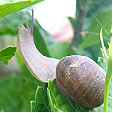
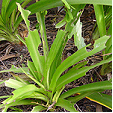
Appearance and Distribution of the Pest
Slugs and snails occur world-wide. Slugs tend to be more prevalent in heavier soil types.
Life Cycle
These insects have a Hemimetabolous life cycle, ie. When the immature nymphs resemble the adults.
Snail eggs are laid in moist soil, 20-40mm deep; eggs are white, spherical and appear in clusters of 30-100. Under favourable conditions, eggs hatch in 2-3 weeks. Newly emerged snails resemble tiny adults. When the weather is cold and dry, snails seal themselves into their shells where they survive, dormant, for 1-3 years.
Period of Activity
More active during the warmer months, although some species may remain active throughout the year.
Damage Caused
Native Australian slugs and snails are not commercial pests. Introduced species chew holes in foliage or skeletonise leaves; some plants may be completely defoliated plants; tubers and seedlings may be completely eaten. Slugs and snails feed mainly at night, especially after rain or watering; they shelter in cool, moist locations during the day. When the weather is dry, snails seal themselves into their shells with a mucous membrane, where they survive, dormant, for 1-3 years. Some species may consume up to one third of their body weight each day.
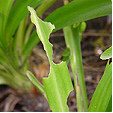

Susceptible Plants
A wide range of leafy plants, including ground crops, potatoes, tubers, leafy vegetables and seedlings.
Fern species are attacked causing serious damage. New fronds are repetitively eaten causing the plant to become stunted. Attacks are normally more severe during wet periods during which time control measures should be taken.
Morinda citrifolia is attacked by the Giant African Snail (Achatina fulica) which defoliates trees.

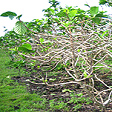
Cultural Control
Remove possible hiding places and avoid overhead watering to reduce humidity. Cultivate soil regularly; in commercial situations, allow the soil to remain fallow for one season to reduce numbers. Domestic infestations may be removed by hand. Traps may be created by inverting small pots near where snails and slugs are feeding; they will gather in these shelters during the day, and may be collected and destroyed. The popular Australian "beer trap" consists of a vertically-sided container, sunk into the ground and filled with beer, which intoxicates and drowns the snails.
Biological Control
Natural predators such as birds, frogs, and lizards reduce numbers, but do not provide effective control. Orchardists have used running ducks to control snails with some success.
Chemical Control
Commercial baits - molluscicides - made from methiocarb or metaldehyde are effective when used in combination with sanitation. Their effectiveness varies according to soil and weather conditions; it is generally recommended to avoid watering after application.
Note
Always read the label for registration details and direction of use prior to application of any chemicals.
PEST
NAME
Aphids
Various Aphid Species
ORDER
Hemiptera
FAMILY
Aphididae
Description of the Pest
The common name varies and aphids may be referred to as black fly, greenfly, ant cows or plant lice.
These small insects have soft globular body that is from 1mm to 8mm long and vary in colour from green, yellow, black and pink, with the winged forms being elongated. Both adult and nymphs, have piercing and sucking mouthparts.
Aphids are found on buds, flowers, or leaves and stems, preferring soft new growth. On older leaves the aphids are found in protected positions, such as under the leaf. Certain species of aphids form galls as they suck sap and may be found on the roots of the plant. (E.g. Woolly aphids and Black peach aphids)
Most aphids possess a pair of characteristic tubular projections, known as cornicles; these secrete a pheromone and a waxy fluid, which is thought to protect them from some of their predacious enemies.
White exoskeletons, honey dew and sooty mould indicate the presence of Aphids
Balsam Twig Aphid (Mindarus abietinus) is greenish and covered in a white wax and is normally found on the young shoots of conifers bending and killing the needles. It is found on Abies and Picea species.
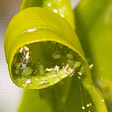 Aphid and their exoskeletons
Aphid and their exoskeletons 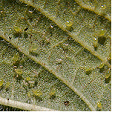 on underside of a leaf
on underside of a leaf
Black Citrus Aphid (Toxoptera aurantii) has a soft plump green body and the black coloured adults may or may not be winged. They feed in groups, curling leaves and producing honeydew attracting sooty mould.
Green Peach Aphid (Myzus persicae) is a soft plump green insect up to 0.2mm long and may be wingless. The nymphs are yellowish green and are responsible for spreading viruses in Dianthus species.
Spruce Gall Aphid (Chermes abietis) form cone shaped galls up to 12mm long resulting from the feeding. The wingless female adult lays eggs on the stems and the immature females overwinter on bud scales. Large infestation will weaken trees such as Picea abies and Pseudotsuga menziesii.
Tulip Bulb Aphid (Anuraphis tulipae) is small, waxy grey coloured and infests the underside of the bulb scales or rhizomes. They occur in the ground or on above ground parts and during storage.
Life Cycle
These insects have a Hemimetabolous life cycle, i.e. The nymphs resemble the adults.
During spring all eggs produced hatch as female nymphs. Adult Aphids are capable reproducing without fertilisation. The males are only produced in some species as the weather cools down, and the day length shortens.
Aphids are capable of giving birth to living young and large populations build up quickly during summer. Over crowding causes the aphids to become smaller, less fertile and produce more winged forms that can migrate to other host plants.
There are many different types of aphids and the life cycle varies from warm to cold climates.
Typical life cycles
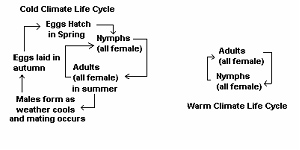
Distribution of the Pest
World wide
Period of Activity
In warm climates they are seen throughout the year, but aphids dislike hot dry or cold conditions and heavy rain will decrease the population. In cold areas aphid eggs are laid around a bud base or other protected areas of the plant during autumn and emerge as nymphs during spring, feeding on the new growth.
Numbers build up quickly in the warmer months of the year. Some species feed during winter on Sow thistles.
Susceptible Plants
There is a wide range of plants attacked, from roses to vegetables, shrubs and trees. Certain aphids attack a specific genus while others have a wide range of host plants. Many are capable of transmitting plant virus diseases.
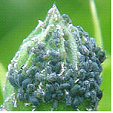 Adults and nymphs feeding
Adults and nymphs feeding 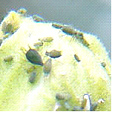 A colony of aphids
A colony of aphids
Acer species are attacked by several aphids including the Norway Maple Aphid (Periphyllus lyropictus) which is a greenish with brown markings and secret honeydew, preferring Acer platanoides. Other aphids include (Drepanaphis acerifolia) and (Periphyllus aceris) which are commonly found on the underside of leaves.
Acer species are also attacked by the Woolly Maple Aphid (Phenacoccus acericola) which covers the undersides of the leaves with a cotton-like mass
Alnus species are infested with the Alder Blight Aphid (Prociphilus tessellates) which is blue-black adult that forms woolly masses on the down-turned leaves. The nymphs overwinter in bark crevices.
Aquilegia species are attacked by several aphids including (Pergandeidia trirhoda) which is a small, flat cream coloured insect that is found on young branches and the underside of leaves.
Betula species may be attacked by the European Birch Aphid (Euceraphis betulae) which is small and yellowish or the Common Birch Aphid (Calaphis betulaecolens) which is large and green producing ample honeydew for sooty mold to grow on.
Callistephus species may be attacked by the Corn Root Aphid (Anuraphis maidi-radicis) causing the plant to become stunted, the leaves wilt and turn yellow. The aphids feed on the roots producing honeydew and are dispersed to other host by ants. It is also attacked by the Potato Aphid (Macrosiphum solanifolii).
Carya species are attacked by Gall Aphids (Phylloxera caryaecaulis) which is found on the leaves, twigs and stems forming galls and turning them black.
Chaenomeles and Gladiolus species, new growth and leaves become infested with the aphid (Aphis Gossypii)
Cupressus macrocarpa may become infested with the Cypress Aphid (Siphonartrophia cupressi).
Cyclamen species are attacked by the aphid (Myzus circumflexus) and (Aphis gossypii) which can infest healthy plants.
Dendranthema, Dianthus and Crocus species are attacked by several types of aphid including the Green Peach Aphid (Myzus persicae) and the Chrysanthemum Aphid (Macrosiphoniella sanborni).
Hibiscus species are attacked by the aphids (Aphis craccivora) and (Aphis gossypii), both congregate towards the branch tips and may cause leaf curl. Normally only seen in sub-tropical climates.
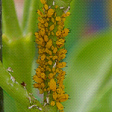 Aphids on a stem
Aphids on a stem 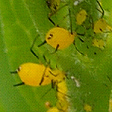 Mandevilla species
Mandevilla species
Larix species is attacked by the Woolly Larch Aphid (Adelges strobilobius). The winged adults deposit eggs at the base of the needles during spring and white woolly areas appear attached to the needles where the adult aphids feed. The young aphids overwinter in the crevices of the bark.
Mandevilla species is attacked by aphids that congregate towards the branch tips and may cause leaf curl.
Pinus species is attacked by several species of aphid including Pine Bark Aphid (Pineus strobi), Pine leaf Aphid (Pineus pinifoliae) and the White Pine Aphid (Cinara strobi).
Primula species are attacked by four species of aphid including foxglove, and green peach aphid.
Rudbeckia, Delphinium, Chrysanthemum and Helianthus species are attacked by a bright red aphid (Macrosiphum rudbeckiae).
Sorbus aucuparia is affected by the Rosy Apple and Woolly Apple aphid which attacked the foliage and young shoots.
Spiraea species are attacked by the Aphid (Aphis spiraecola) which feeds on the young shoots and flowers.
Tropaeolum species are attacked by the Black Bean Aphid (Aphis fabae), which is found in large numbers on the underside of the leaves, turning them yellow and causing them to wilt then die.
Tulipa, Iris, Freesia, Gladiolus and Zephyranthes species are infested with the Tulip Bulb Aphid.
Ulmus species are infected by two types the Woolly Apple Aphid (Eriosoma lanigerum), which curls and kills young terminal leaves and the Elm Leaf-Curl Aphid (Eriosoma ulmi) which occasionally attacks the trees.
Viburnum species are attacked by the Snowball Aphid (Anuraphis viburnicola). This aphid congregates at the end of the branches causing the leaves to curl and become deformed under which they hide.
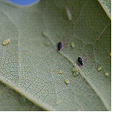 Aphids on Quercus robur
Aphids on Quercus robur
Damage Caused
Buds that have been attacked may not open, leaves and twigs become twisted or distorted and wilt. The aphids also produce honeydew, which is sticky and attracts sooty mould (fungus). This fungus forms a thick layer over the leaf, fruit or stems reducing the plants photosynthesis capability. The sooty mould spoils the plants appearance and its fruit, as does the insects white exoskeletons.
Control
Cultural Control
Aphids may be removed from a plant by hosing them off with water (limited success) or applying soapy water to aphids.. Another organic sprays can be efficient in controlling aphids. Aphids may also be removed physically by hand for small colonies on spine less plants. Species that live under ground are difficult to control but cultivation of the surrounding soil may help in controlling the infestation. (limited mainly to annual or commercial crops)
Reflective mulch around the plants also reduces numbers by repelling the insect this material is available commercially. (Reflective mulches are mainly used in market gardens for avoiding the Green peach Aphids) Resistant rootstocks are available to avoid some root feeding aphid of commercial plants, e.g. Vines and fruit trees
Biological control
Aphids are attacked by several insects includes parasitic wasps or predators such as ladybirds/ lady beetles, hover flies, lacewings, spiders.
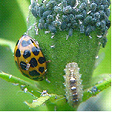
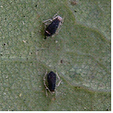 Parasitised aphids
Parasitised aphids
Chemical Control
Aphids may be controlled by spraying with a contact or systemic insecticide. The type of application used will depend on the plant is being attacked.
Aphids can be suffocated and therefore controlled with the use of e.g. White oil, Pest oil, Soapy water from soap such as Lux Flakes ®
Note
It is your responsibility by law to read & follow the directions on the label of any pesticide
Monitoring
Aphid are attracted by yellow colour and traps such as boards painted yellow and covered in glue or sticky substance will attract and trap the insects. There is also a commercially sticky yellow tape that can be attached to susceptible plants
Amendments by B. Sonsie Dip Hort Sc Burnley
PEST
NAME
Looper Caterpillars
Various Looper Caterpillar Species
ORDER
Lepidoptera
FAMILY
Noctuidae
Description of the Pest
The looper is so-called because of the larvae's characteristic "looping" movement: the back legs move forward behind the front legs, causing the body to arch into an inverted "U" shape. They vary in colour and size; Brown Looper (Lophodes sinistraria) can grow to 50mm long, glossy black with yellowish bands then maturing to brown and found in coastal sub-tropical regions.
Green Wattle Looper (Thalaina species) adult is a small white moth with a wing span of 40mm and the lava is a slender green caterpillar with a rounded head. It is commonly found on ferny leaves Acacia species and when it is not feeding it takes up an erect position imitating a twig growing at an angle. It is difficult to detect and normally not requiring control.
Grevillea Lopper (Oenochroma vinaria) is a slender caterpillar that is greyish with orange bands and has two thorn-like projections on its back towards the head that it uses in a defence position. It is hairless with mottled orange colouring and grows to 80mm long. The adult moth (pink belly moth) has a wing span up to 60mm across and is pinkish.
Brown Looper (Lophodes sinistraria) are black with yellowish bands at first maturing to brown growing to 50mm long. It is a solitary feeder eating mature leaves and are found in tropical to sub tropical regions.
Appearance and Distribution of the Pest
Many species are found throughout Australia from tropical to temperate regions.
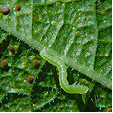
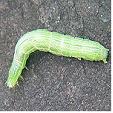
Life Cycle
These insects have a Holometabolous life cycle, ie. When metamorphosis is observed during the pupal stage.
Period of Activity
Most active during the warmer months the larva feed generally in the early morning or in the evening. Caterpillars are also active during cloudy days.
Damage Caused
Larvae are voracious feeders, skeletonising leaves or stripping them to the midrib preferring new growth.. Certain species feed solitary while others in groups.
The Grevillea Lopper feeds solitary or in groups defoliating small areas in species such as Lambertia and Grevillea.
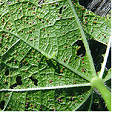
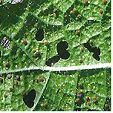
Susceptible Plants
A wide range of native and exotic plants are attacked, depending on the species of looper. Plants with soft-textured foliage (eg vegetables, some indoor plants) are preferred. The Brown Looper is found on Acmena smithii, Waterhousea floribunda and Macadamia species.
Tropaeolum and Calendula species are attacked by the Cabbage Looper (Trichoplusia ni), which feeds on the leaves and flowers.Tropaeolum species are also attacked by the caterpillar (Pieris rapae), which eats the foliage.
Cultural Control
Small numbers may be removed by hand.
Biological Control
Birds and other predators reduce numbers.
Chemical Control
The plant may be sprayed using Carbaryl. During heavy infestations this method is effective.
Note
Always read the label for registration details and direction of use prior to application of any chemicals.
PEST
NAME
Beetles (General)
Various Beetle Species
ORDER
Coleoptera
Description of the Pest
There are many different types of beetles both adult and larvae feed and have chewing mouth parts.
Agave snout weevil (Scyphophorus acupunctatus)
The Agave snout weevil or sisal weevil is a beetle up to 15mm long. It has a dull brownish-black body with a long protruding snout and chewing mouth parts. The adult female lays eggs at the base of the leaves where the hatching larvae feed on the succulent centre of the leaf with their chewing mouth parts and cause significant damage. Decay microbes then entre through the wounds and cause the plant to die by collapsing from the base.
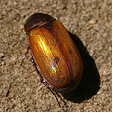
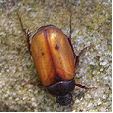 Brown (Scarb) Eucalyptus Beetle
Brown (Scarb) Eucalyptus Beetle
Brown Eucalypt Beetle (Lepidiota rothei) adult is brown with hairy legs and grows to 20mm long. It has chewing mouth parts and feeds on the leaves, sometimes swarming and stripping the host tree. The lava is cream coloured curl-grubs that feed on the roots of the tree. The feeding habits of this beetle are very simular to the Christmas Beetle (Anoplognathus species), eating new shoots and leaves to the mid rib, commonly attacking Eucalyptus species.
European Bark Beetle (Scolytus multistriatus) female adult is reddish up to 3mm long and lays its eggs in tunnels in the sap wood and the emerging lava tunnel through the bark forming tiny holes. This beetle is regarded as a main transmission source for Dutch elm disease that infects Ulmus species.
European Willow Beetle (Plagiodera versicolora) is metallic blue up to 4mm long and overwinters in the bark. During spring the yellowish eggs are laid and the emerging lava skeletonise leaves by feeding on the underside. There can be two generations per year and attack Salix species.
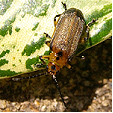 Fig Leaf Beetle
Fig Leaf Beetle 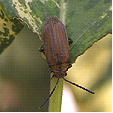
Fig Leaf Beetle (Poneridia semipullata) is a dull brown adult has a reddish brown head and growing to 12mm (¼in) long with prominent antennae. It deposits up to 50 eggs that are in groups on the underside of the leaf. The yellowish spiny larvae are small and appear as sawdust on the leaf. As they mature they turn blackish and grow to 12mm (¼in) long, widest at the head.
It prefers coastal tropical to warm temperate regions and both adult and larvae feed on the leaves. The larva graze in groups skeletonising the leaves and making plants look unsightly.
Figwort Weevils generally the adult beetles are normally black to greyish white, up to 4-5mm long with one or two black circular marks where the wing cases meet. The larvae are yellowish to brown grubs with black heads up to 6mm long and have a slimy texture.
The larvae pupate in spherical cocoons that it spins and is attached to the host stems. The cocoon resembles the seed pods of Scrophularia species (Figwort). Adults overwinter in leaf litter or the soil emerging during spring and lay eggs on the host plant. There is normally two generations per year.
The larvae feed on leaves by grazing the surface of the leaf eating the epidermal layer. The leaf turns brown, shrivels and dies. Many plants are susceptible, including Hibiscus, Dahlia, Vitis species and avocados, potatoes, sweet potatoes, rhubarb, and various weed species.
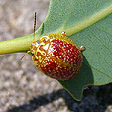
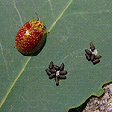 Paropsis species adult and larvae
Paropsis species adult and larvae 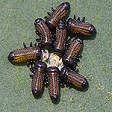
Leaf-eating Beetles in the Chrysomelidae family are found throughout the world with over 3,000 species in Australia. Generally small smooth and colourful, globular or flattened up to 15mm in length with antennae one third the length of the body. Normally adults and larvae feed on the living tissue of the leaves. There are many sub-families including Sagrinae containing the larges species, Bruchinae containing larvae that eat seeds and the larges subfamily Chrysomelinae contains many species such as Paropsis species. These beetles are characteristic dome shape and are commonly seen on Eucalyptus species.
Mountain Pine Beetle (Dendroctonus ponderosae) is a dark brown to blackish adult beetle up to 7.5 mm long. There are 4-larval stages that include a white larval with no legs that appear from vertical egg galleries and mature larval produce oval pupation cells towards the end of the tunnels in the tree. They emerge from small openings at the tunnel end as adults. This pest affects millions of hectares of forest in North America and Canada including many species of Pinus. It normally attacks older weaker trees but under ideal conditions it attacks healthy trees. Pinus albicaulis has become endangered due to the actions of this species. Numerous beetles can attack a single tree and the larval attack on the cambium layer can be accompanied with a fungal attack such as the Blue stain fungi (e.g. Ceratocystsis and Ophiostoma spp.) causing death of the tree. Symptoms include the needles in the crown wilt then turn orange-red for many months then become brown before falling to the ground. Pitch tubes can be located towards the lower part of the tree and consist of frass and resin.
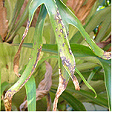 Staghorn Beetle Damage
Staghorn Beetle Damage
Staghorn Beetle (Halticorcus platyceryi) is a small rounded beetle that is black with four dull red spots on the wing covers. It has pinkish lava and both larvae and adult feed on the epidermal layer of fronds leaving small brownish sunken areas.
Wattle Blight (Paropsis orphana) adult is a light green oval-shaped beetle with white stripes on its wing covers up to 6mm long. The small lava has a tapering shape and both adult and lava feed together in groups on the surface of Acacia species leaves turning them brown.
Vegetable Weevil (Listroderes difficilis) is found during cooler weather (spring or autumn). The adult brown beetle up to 19mm long with a "V" mark on its back and the eggs are laid in the soil around the base of the host plant. The cream coloured lava emerges in spring after rain and feed on the lower leaves forming irregular holes or chewing holes in stems. The lava also feed on fleshy roots boring holes into carrots. Both the adults and lava cause damage, feeding on the plant during the night and resting at the base or under ground during the day. The lavae pupate in the soil over winter.
Life Cycle
This insect has a Holometabolous life cycle, i.e. it has a larval and a pupal stage.
Distribution of the Pest
Beetles are found world wide.
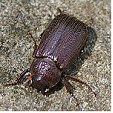
Period of Activity
The beetles are active from spring to mid summer preferring the warmer weather.
Susceptible Plants
The beetles attack many species of trees, shrubs, ferns and small plants as in potted plants in nurseries.
Anemone and Clematis species are attacked by the Black Blister Beetle (Epicauta pennsylvanica) which eats the leaves and flowers.
Callistephus species are attacked by the Asiatic Garden Beetle (Autoserica castanea) that chews on the foliage at night and hides in the soil or around the base of the plant during the day.
Carya species are attacked by the Bark Beetle (Scolytus quadrispinosus). The tiny adult beetle is brown up to 5mm long and the legless lava tunnel the bark and sapwood where it over winters, causing ringbarking. Twigs and small branches wilt and die.
This species is also attacked by the Twig Girdler (Oncideres cingulate), a reddish beetle that is 20mm long and produces small lava that girdles twigs by tunnelling, where it overwinters. This weakens the twigs causing them to snap off or results in ringbarking.
Cheiranthus species may be attacked by the Red Turnip Beetle (Entomoscelis americana) which is bright red with black markings in its head and wing covers and feeds on the foliage.
Eucalyptus species and other plants in the Myrtaceae family are attacked by the Flower Scarab Beetle (Protaetia species) a rounded brownish adult that grows to 20mm long, feeding solitary on flower pollen or new growth causing wilting and twig dieback. The insect is found from tropical to temperate regions and is regarded as a minor pest. Eucalyptus are also attacked by Leaf-eating Beetles which eat irregular pieces from the margins.
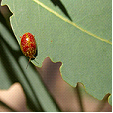 Damaged Margins on Eucalyptus by the Leaf-eating Beetles
Damaged Margins on Eucalyptus by the Leaf-eating Beetles
Protea species are also attacked by the Flower Scarab Beetle.
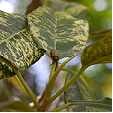 Ficus species
Ficus species 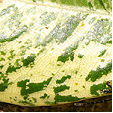 Damaged epidermal layer
Damaged epidermal layer
Ficus species are susceptible to the Fig Leaf Beetle (Poneridia semipullata). Both adult and larvae feed on the leaves eating the epidermal layer and making the plant in large infestations look poorly.
Ulmus species are attacked by the European Bark Beetle and the Leaf Beetle (Galerucella luteola) adult, which eats areas out of new leaves.
Ficus species are susceptible to the Fig Leaf Beetle (Poneridia semipullata). Both adult and larvae feed on the leaves eating the epidermal layer and making the plant in large infestations look poorly.
Samanea saman fruit pods are attacked when the burchid beetle (Merobruchis columbinus) oviposits in the immature fruit. The lava can kill or damage up to 75% of the seeds but is not commonly a major problem.
Solanum tuberosum is attacked by wireworm (Agriotes species). The larvae of this beetle, tunnels into the tubers. It is best controlled by planting in the soil which has not been affected previously.
Ulmus species are attacked by the European Bark Beetle and the Leaf Beetle (Galerucella luteola) adult, which eats areas out of new leaves and its lava skeletonise the underside of mature leaves later in the season.
Damage Caused
Some beetles and their larvae may eat the leaf surface in bands leaving the veins intact while other larger beetles tend to eat leaves from the margins preferring new shoots.
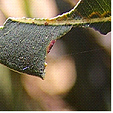 Beetle damage
Beetle damage
Cultural Control
Small infestations may be removal by hand where possible.
The Brown Eucalypt Beetle will not fly during the night and if disturbed by shaking or beating the tree, fall to the ground where they can be collected on a tarp that is laid under the tree then destroyed. This method also works on the Flower Scarab Beetle that fall to the ground pretending to be dead when disturbed.
Biological Control
Beetles are eaten by predators including birds, frogs, and lizards and are attacked by parasitic wasps.
Chemical control
Will vary with the pest, the plant on which it is found. The part of the plant being attacked.
Note
It is your responsibility by law to read & follow the directions on the label of any pesticide
Amendments by B. Sonsie Dip Hort Sc Burnley
PEST
NAME
Cutworms
Agrotis species
ORDER
Lepidoptera
FAMILY
Noctuidae
Description of the Pest
Cut worm larvae live in the soil, congregating in weedy areas; they chew off young seedlings at the base. They are smooth, thick fleshy grubs that vary in colour, from pinkish brown to olive green, or almost black. They grow up to 40mm long and 5mm thick. Larvae curl up when disturbed, pretending to be dead. Larvae burrow down into the soil to a depth of about 50mm to pupate. Adults are dark brown, hairy moths, with a wingspan of about 60mm.
These insects have a Holometabolous life cycle, ie. When metamorphosis is observed during the pupal stage.
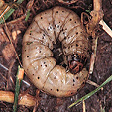
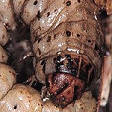
Appearance of the Pest
Adult moths are strong fliers capable of flying many kilometres laying eggs over a wide area. The eggs may remain dormant for several weeks until it rains or emerge within a few days under the right weather conditions.
Three similar species are commonly found in Australia:
· Agrotis ifusa (Bogong moth) is up to 50mm across and has three spots on its forewing.
· Agrotis munda (pink cut worm); and
· Agrotis ipsilon (black cut worm).
 Agrotis munda
Agrotis munda
Period of Activity
Different species are active throughout the year, their prevalence being determined by rainfall and temperature. They are normally most active at night. Larvae will appear in greatest numbers when favourable environmental conditions produce lush growth.
Susceptible Plants
Cutworms prefer soft, succulent seedlings or fleshy annuals, perennials and a variety for ferns or orchids. They feed at night and remain in the soil during the day. They are most commonly found in soil that is infested with weeds or soil that is poorly drained and moist. Well-drained soils harbour less lava.
Senecio and Dianthus species are attacked by the Cutworm (Peridroma margaritosa) which eats seedlings, leaves and flower buds. Under glasshouse conditions all stages of the lifecycle are present.
Turf Grasses are attacked by several Agrotis species causing damage during different seasons according to there individual life cycle. All feed at night on the leaves when young and mature larvae shear plants stems at ground level.
Damage Caused
Young larvae feed on the lower epidermis of leaves. Adults attack stems and seedlings at the base, eating the soft new growth, on one side, or completely through. The damaged plant normally topples over (hence the common name). Mature plants may wilt or the foliage becomes yellowish as a result of the damage, but normally recovers.
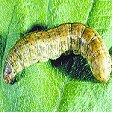
Cultural Control
Weed removal and cultivation to improve the drainage of the soil will provide some reduction in of numbers. Seedlings may be protected by a physical barrier, (eg plastic tube pushed into the soil around the seedling). Heavily infected soil can be laid fallow with for several weeks to disrupt the life cycle or the soil can be covered in black or clear plastic until weeds and lava are dead.
A molasses based bait that has hardwood sawdust and bran mixed with water creates a stick mass that the lava is attracted to but cannot escape. At sunrise they die from dehydration.
Biological Control
Natural predators such as birds, ground beetles and certain bugs help keep numbers down. Wasps and certain species of flies also attack the lava.
Encouraging earthworms by mulching and increasing the humus level is an excellent way to rid the soil of lava.
Chemical Control
Chemical treatment (Carbaryl) may be effective if sprayed in the evening, when the caterpillars emerge to feed.
Note
Always read the label for registration details and direction of use prior to application of any chemicals.
Note: Plants affected by this pest are the Rabbit Resistant plants not the susceptible plants.
PEST
NAME
Rabbits
Oryctolagus cuniculus & Sylvilagus species
ORDER
Lagomorpha
FAMILY
Leporidae

Description of the Pest
There are a eight different genera in the family classified as rabbits and include the European Rabbit (Oryctolagus cuniculus) which has infested Australia and the Cottontail rabbit (Sylvilagus spp.) which consists of 13-species with 9-species found in North America.
Generally rabbits have an egg-shaped body that can range in size from 200 mm to 500 mm long and weigh up to 2 kg. They have long ears that are adapted for detecting predators and powerful large hind legs allowing them to move fast. The body is covered in buffed, long soft fur that is brown or grey and the mouth has two sets of incisor teeth which are located one behind the other.
The cottontail rabbit grows up to 450 mm (18 in) tall and weighs 1.36 kg (3 lbs).
Appearance and Distribution of the Pest
Generally rabbits live in a variety of habitats including meadows, woodlands, forests, grasslands or deserts and wetlands living in groups with some underground in borrowers. The European Rabbit has been introduced to many parts of the world and in 1859 Thomas Austin brought 24 breeding pairs to Australia which subsequently escaped and quickly bred throughout Victoria and New South Wales and by the 1900's the rabbits had reached the Northern Territory and Western Australia.
Life Cycle
The life span varies with each species. Cottontails for example can live for one year to a maximum of three years in the wild but in captivity they can last for eight years, during which time they can raise between 2-6 litters per year and produce up to 18 kittens during the breeding season. In the cooler northern parts of North America the size and number of litters are generally smaller only 2-3 but in southern regions such as Mexico or Australia, European rabbits can produce 5-6 litters per year, normally commencing during spring time and continuing throughout the year. Each litter can consist of 2-8 or more kittens. Under ideal seasonal conditions a mature doe (female) can mate again several hours after giving birth and has a gestation period from 28-30 days.
Period of Activity
Generally rabbits eat throughout the year but in cooler countries such as North America they are more active during the spring to summer period but in warmer climates such as Australia rabbits can cause significant damage throughout the year.
Damage Caused
in Australia the effects of rabbits on the landscape has been a devastating resulting in the loss of an unknown number of plant species and a ring barking of young trees in orchards or forests. Major erosion problems have also resulted from warrens or plant denuded landscapes which are left vulnerable to the elements.
A rabbits generally will eat most flowers or the bark of woody plants, grasses of all types and most agricultural crops (vegetables).
Susceptible Plants
Rabbits mainly consumed grasses or garden vegetables and a broad range of ornamental plants. In cool climates where snowfalls rabbits eat twigs, bark and buds from the dormant plants. When rabbits are hungry they will eat most plants but attached to this file are rabbit resistant plants that are less palatable. Their resistance will vary depending on the stage of growth as new shoots are very desirable to rabbits.
Cultural Control
Control methods include trapping, hunting and exclusion with the use of fences, all of which had a marginal success. Many predators utilise rabbits as a food source for example foxes, feral dogs and cats, hawks or owls and human hunters.
Biological Control
In Australia to biological diseases have had reasonable success. In 1950 Myxomatosis was released into the rabbit population and resulted in the numbers dropping from 600 million to 100 million. Remaining populations became immune and steadily increased numbers to 300 million by the 1990s. The calicivirus was accidentally released in 1996 and culled populations significantly in regions of extreme heat but was less effective in cooler regions where the rabbits were exposed to a lesser calicivirus that immune them.
Chemical Control
Baiting and chemical repellents programs relied on the territorial habits of rabbits as they rarely forage further afield from their territorial areas.
Note
Landholders should seek advice from their local government agencies. This advice will include fumigation or destruction of warrens, fencing and shooting.
DISEASE
NAME
Powdery Mildew
Various Powdery Mildew Species
Description
Powdery mildew covers arrange of fungal infections most with simular characteristics of white powdery areas appearing on the leaves and flowers.
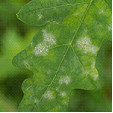
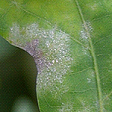 White powdery area
White powdery area 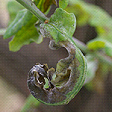
Symptoms
Powdery mildew (Oidium species) affects the following five plant groups with slightly different characteristics.
Cucurbits firstly form white spots on the underside of the leaves. Under optimum conditions the fungus spreads to the upper surface covering the entire leaf causing it to die. It may also extend to the stems slowing the growth of the plant and may reduce the size of the fruit.
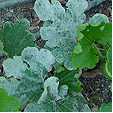
Grape leaves, flowers and fruit are attacked with the appearance of greyish-white powdery spots. Infected flowers set poor quality fruit and infected fruit splits open and dries out.
Pawpaw leaves become infected on the underside at first then spreading covering the entire leaf. The fruit forms irregular light grey spotted areas that damages the surface and under the surface causing the fruit to misshapen and reducing its market value.
Rose leaf and buds are covered in a fine white powdery coating and in severe cases it extends to the stems. When young leaves are infected they become distorted and older leaves develop blackened areas. Infected flower buds may fail to open and opened blooms may be discoloured or distorted.
Strawberries show different signs of infection with the leaf margins first rolling upwards then developing purplish irregular blotches along the veins. The infected flowers may fail to set fruit and if fruit is produced it is small, hard fails to ripen. Semi mature fruit that is infected has dull appearance and may form cracks or split open.
The Powdery Mildew (Sphaerotheca lanestris) infects leaves and twigs. The under side if the leaf firstly has a white mealy growth that matures to felt-like brown mycelium that can cover the entire leaf, and the twig tips. It is only one of the many types that infect Quercus species.
Source and Dispersal
The spores overwinter in fallen leaves, dormant buds, seed and infested plants. It is dispersed by wind.
Favoured Conditions
Generally it prefers warm humid conditions, but failing to germinate when it is raining. The fungus that attacks Pawpaw prefers cooler conditions disappearing in the warmer months.
Affected Plants
There are many plant species ornamental trees and shrubs that are attacked by Oidium species including; Roses, African Violets, Cucurbits, Grapes, Pawpaw, Strawberries, Hydrangeas, Ajugas, Antirrhinum, Oaks and Photinias.
Acer species are infected by the powdery mildews (Uncinula circinata) and (Phyllactinia corylea) but are not normally serious.
Aesculus species are infected by the powdery mildew (Uncinula flexuosa) which forms a white mold on the underside of the leaves.
Arenaria,Cuphea, Erica and Eschscholtzia species are infected by the powdery mildew (Erysiphe polygoni). This fungus is greyish or white and covers leaves or young shoots. Heavenly infected leaves turn brown and fall from the plant. The plant eventually dies.
Aster species are infected with the powdery mildew (Erysiphe cichoracearum) which is more prevalent on the lower part of the plant.
Ceanothus, Corylus, Platanus, Syringa and Weigela species are infected by the powdery mildew (Microsphaera alni) particularly London Plane. The mycelium forms a felt-like cover on the leaves.
Celtis species are susceptible to the powdery mildew (Uncinula parvula) and (Uncinula polychaete). This fungal problem can affect either side of the leaf, which can have spots or be completely coved in mildew. The fruiting bodies appear on the opposite side of the mildew.
Cornus species leaves are infected by the powdery mildew (Microsphaera alni) and (Phyllactinia corylea), covering the leaves in a whitish fungus.
Dahlia species are infected by the powdery mildew (Erysiphe cichoracearum) that forms white powdery areas on the leaf surface.
Lagerstroemia species are infected by the powdery mildew (Uncinula Australiana) that forms white powdery growth on the leaves and may also distort the infected foliage.
Populus and Salix species are infected by a white powdery mildew (Uncinula salicis) that produces black fruiting bodies with a curled tip, but is not normally a major problem.
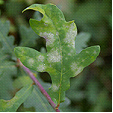
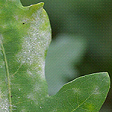 Quercus robur
Quercus robur
Quercus species are susceptible to several powdery mildew fungi including (Sphaerotheca lanestris), (Erysiph trina) and (Phyllactinia corylea). Generally white mealy growth appears on the leaves, normally on the underside turning the infected areas brown and then the leaf dies. The infection may spread to the twig tips causing dieback. Control may be difficult and unwarranted on large trees but nursery stock may be sprayed with a fungicide during susceptible periods.
Rosa species are also infected by the powdery mildew (Sphaerotheca pannosa).
Rudbeckia and Senecio species are covered in white fungus (Erysiphe cichoracearum) which infects leaves, flowers and stems. This results in the plant becoming stunted.
Senecio species are infected by the powdery mildew (Sphaerotheca fuliginea) which forms circular white powdery areas on the leaves.
Spiraea species are infected by the Powdery Mildew (Microsphaera alni) and (Podosphaera oxyacanthae).
Ulmus and Rhododendron (Azalea) species are also infected by (Microsphaera alni). Circular patches of white powdery growth appear on the leaves.
Veronica species are sometimes infected by the powdery mildew (Sphaerotheca humili) causing a white coating to appear on the leaves. Not normally a major problem.
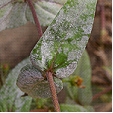
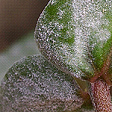
Zinnia elegans are commonly infected by the powdery mildew (Erysiphe cichororacearum), which appears on both sides of the leaves as a greyish powdery cover and may be transmitted by seed.
Non-chemical Control
Choose less susceptible species and when planting space the plants to allow good air circulation. Avoid overwatering and try to keep the foliage dry. Affected plants may be dusted with powdered sulphur or sprayed with a milk mixture to discourage mildew. Vegetables that are infected with mildew should be removed and replaced with new young plants, as they are more resistant to infection.
Chemical Control
Prenatitive spraying during warm humid conditions using a suitable fungicide such as wettable sulphur, bitertanol, carbendazim, fenarimol and triforine helps control the problem.
Note
Always read the label for registration details and direction of use prior to application of any chemicals.
DISEASE
NAME
Leaf Spot (General)
Various Leaf Spot Species
Description
There is a wide variety of fungal leaf spots that infect perennials, shrub and trees. Some are specific to the host while others can affect a range of plants.
Symptoms
Generally light brown to purplish or blackish spots appear on the leaf and form concentric rings of fruiting bodies. The spots may leave holes, perforating the leaf or expand with pale green to yellowish margins and when the holes merge the leaf normally dies. There are many different types of leaf spot, some are discussed below.
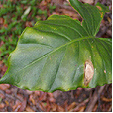 Alocasia species
Alocasia species 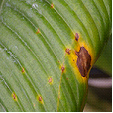
Alternaria Leaf Spot (Alternaria nelumbii) forms a small reddish brown spots that are boarded in light green, and as they develop in size the leaf curls and dies from the margin inwards. Normally occurs on Nelumbo species (water lilies).
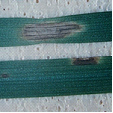 Helminthosporium Disease
Helminthosporium Disease
Helminthosporium Disease (Bipolris species), (Drechslera species) and (Exserophilum species) are responsible for several leaf spots that occur on all Turf Grass species. Generally they form black or white spots that may be faded and produce masses of spores in the thatch during late summer, under humid conditions. The life cycle is short and when conditions are favourable spores are splashed onto the foliage from the thatch, causing wide spread infection. Cynodon dactylon (common couch) is most susceptible and found in bowling or golf greens where it is a serious problem.
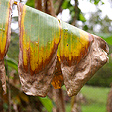 Banana Leaf Spot
Banana Leaf Spot 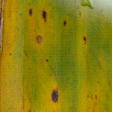
Banana Leaf Spot (Mycosphaerella musicola) is found on many species of banana causing pale yellow streaks on the young leaves to turn brown with dark spots. The leaf then becomes dried, brown and dead commencing from the margins, eventually the leaf dies. Control requires removal of infected foliage or the spraying of a fungicide and fungicides should not be used during the fruiting period.

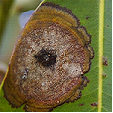 Lophostemon confertus (Brush Box)
Lophostemon confertus (Brush Box)
Leaf Spot on Brush Box (Elsinoe species). This is a casual fungus that attacks the epidermal layer of the leaf, forming circular spots that are up to 25mm across and are often restricted by the main vein. These spots are a dull yellowish brown but can also have purplish patterns. A leaf may have more than one spot develop on its surface and normally appears on scattered leaves throughout the tree. This doesn't affect the vigour of Lophostemon confertus.
Palm Leaf-scab (Graphiola phoeicis) appears as yellow spots and develop into scabs or warts that are outwards hard and dark but with a soft centre with powdery yellowish brown spores. The infected leaves eventually die.
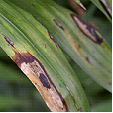 Palm Leaf Spot, Chamaedorea elegans
Palm Leaf Spot, Chamaedorea elegans
Palm Leaf Spot (Pestaloptiopsis species) appears as a small spot with a dark centre on the leaves and affects palms that are growing in shaded humid positions and normally control is not required, though infected fronds should be removed.
Source and Dispersal
Infection source is other contaminated plants and the spores are spread by wind or by splashing water. The fruiting bodies are black spots that appear on the damaged tissue releasing spores.
Favoured Conditions
This fungus prefers a warm humid environment and leafy plants with soft new growth, particularly if they are crowded.
Affected Plants
There are many ornamental and native plants that are hosts to a wide range of fungal leaf spots. Some specific ones are listed below. Plants such as Cornus or Paeonia species are infected by a large variety of leaf spots, while other plants attract a specific leaf spot.
Generally a healthy plant can tolerate fungal leaf spot attack, though it may make the plant look unsightly. In trees and shrubs it is difficult to control and generally not necessary, but in perennials and annuals control may be necessary in order to save the plant.
Acalypha and Arctotis species are infected by up to three leaf spots including (Cercospora acalyphae) and (Ramularia acalyphae) that rarely require control.
Acer species are infected by Purple Eye (Phyllosticta minima) which forms spots with brownish centres and purplish margins causing the death of the leaves.
Acer species are also infected by Tar Spot (Rhytisma acerinum) which forms round black spots that have yellow margins. Not normally seen on cultivated trees, but seen in forests.
Adiantum, Asplenium, Blechnum, Cyathea, Davallia, Nephrolepis, Platycerium, Polypodium and Pteris species are infected by the leaf spot (Pseudocercopora species) which forms circular brown spots on the fronds and heavy infection can defoliate a plant.
Aesculus species are occasionally infected with the leaf spot (Septoria hippocastani) which forms small brown spots.
Agave species are susceptible to the leaf spot (Coniothyrium concentricum), which appear as greyish spots up to 20mm (1in) across with concentric rings and black fruiting bodies. Affected leaves are destroyed as the infection spreads.
Albizia julibrissin is susceptible to the fungal leaf spot (gloeosporium aletridis), which does not normally require control.
Amelanchler, Chaenomeles, Crataegus and Rhaphiolepis species Mespilus germanica are infected by the leaf spot (Fabraea maculata) which may cause considerable damage during wet periods.
Aquilegia species can be infected by three types of Leaf Spot including (Ascochyta aquilegiae), (Cercospora aquilegiae) and (Septoria aquilegiae), normally appearing during humid conditions forming spots on the leaves.
Arbutus species are infected by two leaf spots (Septoria Unedonis) which produces small brown spots on the leaves and (Elsinoe mattirolianum).
Arctostaphylos manzanita is infected by the leave spot (Cryptostictis arbuti) which damages leaves but is not normally detrimental to the shrub.
Aspidistra species are infected by the leaf spot (Colletotrichum omnivorum) causing whitish spots on the leaves and petiole.
Aster species are infected by many leaf spots including (Alternaria species), (Cercosporella cana), ( Ovularia asteris) and (Septoria asteris).
Aucuba species are infected by several leaf spots, usually as a secondary infection after aphid attack. These include (Phyllosticta aucubae) and (Phyllostica aucubae).
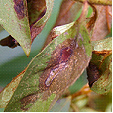
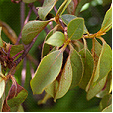 Azalea
Azalea
Azalea (Rhododendron species) are susceptible to Leaf Scorch (Septoria azalea). This fungal disease forms reddish- brown spots which expand and engulf the leaf, with fruiting bodies appearing in the centre. Infected leaves die, then fall and the branchlets wilt. This problem is more serious during wet periods and may require control using a fungicide.
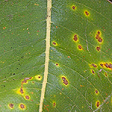 Banksia robur
Banksia robur
Banksia species are infected by several leaf spots causing chlorotic areas that have brown centres and is not normally a major problem for the plant.
Betula species may be infected by the Leaf Spots (Gloeosporium betularum) that forms brown spots with darker margins and (Cylindrosporium betulae) that also forms brown spots with faded indefinite margins.
Bougainvillea species are infected by the leaf spot (Cercosporidium bougainvilleae) which forms rounded spots with dark margins that yellowish ting. Infected leaves die and fall from the plant.
Calendula species are infected by the Leaf Spot (Cercospora calendulae) which rapidly infects the plant spotting the leaves and killing the plant.
Callicarpa species may be infected by the leaf spot (Atractilina callicarpae) forming irregular brownish spot or (Cercospora callicarpae) which can defoliate the plant in subtropical climates.
Campsis species may be infected by several fungal leaf spots including (Phyllosticta tecomae), (Septoria tecomae) and (Cercospora duplicata).
Carpinus species are infected by the leaf spots (Gloeosporium robergei), (Gnomoniella fimbriata) and (Septoria carpinea), all are minor infections not normally requiring control.
Carya species are infected by several leaf spots including (Gnomonia caryae) that infects leaves with irregular reddish spots on the upper surface with corresponding brown spore producing spots on the underside. It also has a secondary spore release that occurs on the dead leaves where it over winters. Other leaf spots include (monochaetia desmazierii) and (Marssonina juglandis).
Ceanothus species are susceptible to the leaf spot (Cercospora ceanothi) and (Phyllosticta ceanothi) both are of minor importance not requiring control.
Celtis species are infected by many leaf spots including (Cercosporella celtidis), (Cylindrosporium celtidis), (Phleospora celtidis) and (Septogloeum celtidis).
Chrysanthemums species are infected by the leaf spot (Septoria species) which forms yellow spots appear toward the edge of the leaves; these become enlarged brownish patches with yellow margins. Damaged areas may converge and in severe attacks and the leaves may fall prematurely or flower production is reduced.
Clematis species are infected by the fungal disease (Ascochyta clematidina) which may cause stem rot or leaf spots that are water soaked areas with reddish margins. The infection spreads from the leaves to the stem causing wilting and eventually girdling the stem killing the plant. There are many fungal leaf spots that infect this plant including (Cercospora rubigo) and (Septoria clematidis)
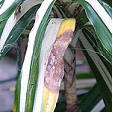 Dracaena deremensis
Dracaena deremensis
Cordyline and Dracaena species may be infected by the leaf spot (Phyllosticta maculicola) which forms small brownish spots that have yellowish margins and has black fruiting bodies that forms coils of spores. These plants are also susceptible to other leaf spots such as (Glomerella cincta) and (Phyllosticta dracaaaenae). Keep foliage dry to avoid infection.
Cynodon dactylon, Pennisetum clandestinum and many other Turf Grasses are susceptible to Helminthosporium Disease.
Daphne species are infected by the leaf spot (Gloeosporium mezerei) and (Marssonina daphnes) both of which form thickish brown spots that are seen on both sides of the leaves. Infected leaves turn yellowish before dieing.
Dendranthema species are infected by many leaf spots such as (Septoria chrysanthemi) which first forms yellowish spots up to 25mm (1in) across that become black. Infected leaves die prematurely and persist on the plant.
Dianthus species may be infected by the leaf spot (Septoria dianthi). It forms light brown rounded spots that have a purplish border. The scattered spots on the lower leaves can also be found on the stems and the spores are dispersed by water from the tiny black fruiting bodies.
Dieffenbachia species are infected by several leaf spot fungi including (Cephalosporium species) and (Myrothecium species).
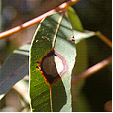 Eucalyptus species
Eucalyptus species
Eucalyptus species are infected by many fungal leaf spots such as (Mycosphaeralla species), (Hendersonia species) and (Monocheatia monochaeta). Generally leaf spots appear on the juvenile or new leaves causing brownish spots that enlarge and may have a purplish halo around the margin. Mature adult leaves are not normally infected and the trees rarely require control measures.
Fern species are infected by the leaf spot, (Alternaria polypodii). This fungus appears as brown circular or oblong spots that congregate along the margins of the pinnae causing the fronds to turn brown and die. It is spread by wind currents from plant to plant and control methods include removing infected fronds and maintaining a drier atmosphere.
Ficus species are infected by various fungal leaf spot including (Pseudocercospora species). Generally the fungal attack forms circular or irregular dark coloured spots on the leaves eventually causing them to fall prematurely.
Ficus elastica is susceptible to many fungal leaf spots including (Alternaria species), (Leptostromella elastica) and (Phyllosticta roberti).
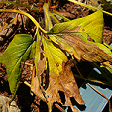
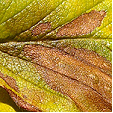 Strawberry
Strawberry
Fragaria x ananassa (Strawberry) is infected by the fungal leaf spot (Mycospharella fragariae). The mature leaf is initially infected with well defined brown spots that that turn light grey with red-purplish margins. As the spots merge they form large brown blotches and the leaf turns yellow then dies. This fungal attack normally occurs on plants in poor health and can be a serious problem early in the season seriously damaging stock.
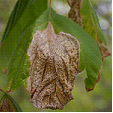 Fraxinus species
Fraxinus species
Fraxinus species are infected by the leaf spot (Gloeosporium aridum) giving the leaf a scorched appearance as large blotches appear from the margin or apex and turn brown with a papery texture. It is more prevalent during rainy periods and infected leaves fall prematurely. Collect and depose of fallen leaves otherwise control is not normally required.
Fuchsia species may be infected by the leaf spot (Septoria species) or ( Cercospora species), both form spots with dead centres and dark margins.
Gladiolus species are infected by Hard Rot or Leaf Spot (Septoria gladioli). On the corms reddish brown circular water soaked spots become large and sunken. These areas dry out and form obvious margins. The leaves may also have these symptoms but is not commonly seen.
Hemerocallis species are infected by several leaf spots including (Cercospora hemerocallis) and (Heterosporium iridis). These may be in the form of black spots or brownish spots that converge killing the leaf. Infected leaves should be removed and burnt.
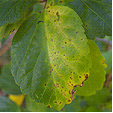 Hibiscus species
Hibiscus species
Hibiscus rosa-sinensis, Hibiscus syriacus and Hibiscus tiliaceus are susceptible to several fungal leaf spots including (Ascochyta abelmoschi), (Cerospora kellermanii) and (Phyllosticta hibiscina). All cause spotting or blotching of the leaf surface; remove and destroy infected parts.
Hydrangea species are infected by four fungal species including (Ascochyta hydrangeae), (Phyllosticta hydrangeae) and (Septoria hydrangeae).
Iris species are infected by several fungal leaf spots including (Alternaria iridicola) and (Macosphaerella species).
Iris species are also infected by the leaf spot (Didymellina macrospore) that forms greyish spots with brown water soaked borders and coalesce on the upper part of the leaf. This casual organism commonly occurs after flowering killing the leaves but will not infect the bulbs. The bulbs become weak over several seasons due to the decreased foliage.
There is also a Bacterial Leaf Spot (Bacterium tardicrescens) that is commonly mistaken as a fungal problem causing translucent spots that coalesce and involve the entire leaf. Normally found on Iris species.
Laburnum anagyroides is infected by the Leaf Spot (Phyllosticta cytisii). The leaf forms light grey spots with no definite margin and mature to brown. The black fruiting bodies appear as dots in the centre of the spot.
Leucanthemum species are infected by the leaf spot (Cerocspora chrysanthemi) and (Septoria leucanthemi).
Magnolia species are susceptible to many species including (Alternaria tenuis), (Mycosphaerella milleri) and (Phyllosticta species). Leaves generally turn brown from the apex or margins turning brown or spots appear on the leaf surface and leaves become yellow before withering and dieing. Normally the make the tree look poorly but have little effect on its growth. Control is not normally required.
Nerium oleander is susceptible to several fungal leaf spots including (Cercospora nerella), (Cercospora repens), (Gloesporium species) and (Phyllosticta nerii). Infected leaves should be removed but generally control is not required.
Nyssa sylvatica is infected by the leaf spot (Mycosphaerella nyssaecola) forming irregular purplish blotches.
Orchids such as Cattleya, Cymbidium, Cypripedium, Dendrobium, Epidendrum, Paphiopedilum, Phalaenopsis and Zygopetalum species are infected by several leaf spots including (Cerospora, Colletotrichum and Phyllosticta species). Normally forming dark or dead, circular or irregular areas on the leaves.
Palms such as Syagrus, Howea, Phoenix, Roystonea and Washingtonia species are infected by Leaf-scab (Graphiola phoeicis).
Palms such as Archontophoenix, Caryota, Chamaedorea, Cocos, Dypsis, Howea, Liculia, Linospadix, Livistona, Phoenix, Ptychosperma, Rhapis, Roystonea, Syagrus, Washingtonia and Wodyetia species are susceptible to several fungal leaf spots including;
(Bipolaris spp.), (Cylindrocladium spp.), (Colletotrichum spp.) and (Pestalotiopsis spp.).
Generally the circular leaf spots are brown and may have a yellow halo such as Palm Ring Spot (Bipolaris incurvata). They vary in size from small to large depending on the species. When a plant is healthy it recovers from attack, but heavy infections can defoliate, causing the collapse of the plant.
Palms are also infected by the Brachybasidium Leaf Spot (Brachybasidium pinangae). This fungus forms angular leaf lesions that produce fruiting bodies on the underside and is commonly found on Archontophoenix species.
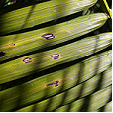
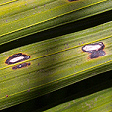 Archontophoenix cunninghamiana
Archontophoenix cunninghamiana
Passiflora species are infected with many types of leaf spot such as (Alternaria passiflorae).
Phoenix species are susceptible to False Smut (Graphiola phoenicis). This fungus forms yellow leaf spots that become hard with a raised with a blackish scab, which produces masses of powdery spores that are thread-like.
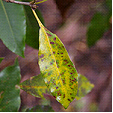
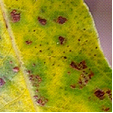 Pittosporum species
Pittosporum species
Pittosporum species are susceptible to the leaf spots (Alternaria tenuissima), (Phyllostica species) and (Cercospora pittospori). Circular or angular dark spots appear on the leaves and are surrounded by necrotic areas that are yellowish. Generally removal of infected leaves is adequate control.
Poa species and other cool season grasses are infected by Winter Fusarium Leaf Disease (Fusarium species), which causes small pale spots that are water soaked to appear on the leaves that turn red-brown. Infected leaves become bleached then wither and die, but the infection will not affect the crown or roots of the plant. It can be identified by pink, cotton-like mycelium and the plant prefers cold wet weather.
Populus species are infected by several fungal leaf spots including (Ciborinia bifrons, Ciborinia confundens), and (Mycosphaerella populicola).
Prunus species are infected by several leaf spots including (Cercospora circumscissa and Septoria ravenelii).
Pseudotsuga menziesii Douglas Fir is infected by the Leaf Cast (Rhabdocline pseudotsugae) Symptoms include the needles becoming yellowish at the apex and extending down the needle and spreading to others during moist spring weather turning them brown. Brownish scorched areas are noticeable on the tree from a distance. Control; is not normally required for mature trees but nursery stock may require spraying with a copper based fungicide.
Psidium guajava (Guava) is infected by (Glomerella cingulate). This fungus courses spots to appear on leaves and mummifies and blackens immature fruit or rots mature fruit. This fungus can devastate a guava crop.
Quercus species are infected by several types of leaf spot including (Cylindrosporium microspilum) and (Marssonina martini). These attacks tend top take place later in the season and normally not detrimental to the tree.
Rhododendron species are infected by a large variety of fungal leaf spots including (Cercospora rhododendri) and (lophodermium melaleucum)
Salix species are infected by several fungal leaf spots including (Ascochyta salicis) and (Septogloeum salicinum).
Senecio species are infected by the fungal leaf spot (Alternaria cinerariae) and (Cercospora species), forming dark rounded or angular spots.
Spiraea species are attacked by the fungal leaf spot (Cylindrosporium filipendulae).
Stenotaphrum secundatum (Buffalo) turf grass is susceptible to Grey Leaf Spot (Pyricularia grisea) in domestic and commercial situations devastating lawns. This fungal disease infects the stems and leaves with small brown lesions that enlarge rapidly forming grey-brown spots that have darker borders or surrounded by yellow chlorotic areas. This infection is commonly found on newly laid turf but will also infect established lawns. It is most prevalent during warm humid periods in soil with a high nitrogen level.
Syringa species are attacked by up to six species of leaf spot including (Cercospora lilacis) and (Phyllostica species).
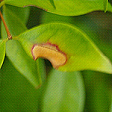 Syzygium species
Syzygium species
Syzygium species are infected by fungal leaf spots but normally control is not required.
Tagetes species are infected by the leaf spot (Septoria tageticola), which starts at the base and moves progressively up through the plant, covering the leaves in grey to black spots.
Trillium species are host to several leaf spots, including (Colletotrichum peckii) (Gloeosporium Trillii) (Heterosporium trillii).
Ulmus species are infected by many fungal leaf spots including (Gnomonia ulmea) and (Cercospora sphaeriaeformis).
Veronica species are infected by the leaf spot (Septoria veronicae). The symptoms include small violet to brown spots appear on the upper surface of the leaf and correspondingly yellowish brown on the underside. The spots converge forming a scorched shot-hole appearance and eventually death of the leaf.
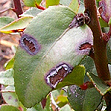 Vaccinium ovatum
Vaccinium ovatum
Vaccinium ovatum is infected by the leaf spot (Rhytisma vaccinii) and (Dothichiza caroliniana).
Vicia species are infected by the leaf spot (Erostrotheca multiformis), which forms greyish spots that enlarge and may defoliate the plant.
Wisteria species are infected by three fungal leaf spots (Phyllostica wisteriae), (Septoria wisteriae) and (Phomatospora wisteriae).
Non-chemical Control
Remove and destroy infected plant material and avoid overhead watering. When planting select infection resistant varieties. Practice crop rotation and add pot ash to the soil to decrease the plants venerability to the disease. Many species of fungus overwinter in fallen leaves, remove and destroy any litter under the plant.
Winter Fusarium Leaf Disease in Turf Grasses can be minimised by aerating the soil, reducing thatch and avoid excessive nitrogen in the soil.
Chemical Control
Protective fungicides such as zineb or copper oxychloride should be sprayed at the first sign of infection and cuttings should be sprayed as they start to grow.
Note
Always read the label for registration details and direction of use prior to application of any chemicals.
DISEASE
NAME
Crown Gall
Agrobacterium and other species
Description
Bacterial problem that is associated with wounds, caused by insects or physical damage in plant tissues.
Symptoms
Soft galls appear on the roots, base and up the stem becoming hard with age. The plant responds by loosing vigour and may produce less flowers or fruit.
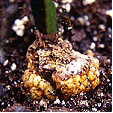
Source and Dispersal
The spores are found in the soil or are released from decaying galls and are spread by infested soil or plant material and contaminated tools.
Favoured Conditions
Continuous cultivation of infested plants allowing a build up of spores in the soil and poor propagation methods during grafting or handling transmits the disease.
Affected Plants
There are many species of woody plants that are affected these include, species in the Rosaceae family, Dahlias, Geraniums, Vitis and Brachychiton species.
Araucaria, Arbutus, Begonia, Chaenomeles, Corylus, Euonymus, Euphorbia, Leucanthemum, Protasparagus, Thunbergia and Wisteria species are infected by a simular crown-gall (Erwinia tumefaciens) which causes smooth swellings to appear on the roots and main stems of the host.
Large cactus species are attacked by the Crown Gall (Agrobacterium tumefaciens). It develops galls on segments and roots with some of the aerial galls attaining a diameter of over 600 mm. Root galls, become a spongy and may attain a diameter of 300 mm. Galls on aerial parts may be cut from the plant with some success. Control methods include not damaging the plant surface and any bacteria contaminated soil should not be used for propagation.
Sorbus aucuparia is seriously affected by this disease.
Non-chemical Control
Remove and destroy any infected plants and avoid replanting in the same area with susceptible species. Care should also be taken when selecting new plants that they are not infected, look for lumps at the base of the plant. Disinfect pruning or grafting tools to inhibit transmitting the disease.
A treatment of control is to dip seeds, cuttings and seedlings into a solution of a non-pathogenic strain of bacteria such as Agrobacterium rhizogenes before planting. This is commercially available under several brand names.
Chemical Control
There is no chemical control of this bacterial problem.
Note
Always read the label for registration details and direction of use prior to application of any chemicals.
DISEASE
NAME
Rust (General)
Various Rust Species
Description
Generally this fungal problem involves many species causing a range of symptoms, but generally produces pustules that release reddish - brown spores. Most fungus is specific to its host and normally will not infect other plant species.
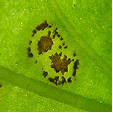 Pustules
Pustules
Symptoms
The upper leaf surface develops red, brown or yellow areas and the underside produces bright yellow to orange spores that correspond to the patches above. Infested leaves become brown in patches, fall prematurely and flower and fruit may also be infected. This overall, results in a loss of vigour and in small plants may lead to death.
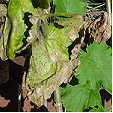 Pelargonium x hortorum
Pelargonium x hortorum
Myrtle Rust (Puccinia psidii) This fungal disease infects plants in the Myrtaceae family and was only recently detected in 2010 and has since spread across eastern Australia from the Northern Territory to Queensland, NSW, Victoria and Tasmania. This rust attacks soft and actively growing foliage or shoots with varying symptoms. It normally starts as small purple spots on the leaves from which spores form in yellow pustules that fade to grey as the infection matures and can merge creating leaf distortion and death of the plant.
The life cycle starts when the powdery yellow spores are distributed by wind to other plants where they germinate and start to grow by piercing the plant cells to obtain nutrients. Germination occurs in dark moist positions with a temperature between 15° to 25°C and the new pustules can release spores in 10 to 12 days, (spores remain viable for 3-months). The spores spread rapidly by wind, water, insects or animals. They are also distributed by plant material, clothing, shoes and vehicles.
 Puccinia psidii
Puccinia psidii
Needle Rust (Melampsora farlowii) infects the new leaves turning them to yellow and fall from the shoot giving the branch a scorched appearance. The fruiting bodies are found on the underside of the leaf and is waxy-red.
Rust in Poplar (Melampsora species). A fungal problem involving at least two species (Melampsora medusae) and (Melampsora larici-idaei).
The upper leaf surface becomes flecked with yellow to light green and the underside produces bright yellow orange spores that correspond to the patches above. Infested leaves become brown in patches, fall prematurely and shoots may die back as a result of not being hardened off to the elements. This overall, results in a loss of vigour and in small plants may lead to death.
The source of the fungus is from other infected plants or fallen leaves and is dispersed by wind.
Host plants include Lombardy Poplars particularly Populus nigra 'Italica' and cottonwoods.
White Rust (Albugo candida) forms snow white pustules that contain colourless spores that turn yellow then brown and are found on the underside of leaves.
White Pine Blister Rust (WPBR) is caused by the fungus (Cronartium ribicola). It is a obligate parasite requiring a living host to survive. The life cycle requires two host species with part of it life on the Pinus species and the other part on Ribes species. First cankers or sores appear on the Pinus species realising spores that land on the Ribes species infecting it. The infection produces a different type of spore that land on the needles and growing branches of the Pinus species and eventually forming cankers. The spores are spread by wind and prefer cool moist conditions. Symptoms include brown spots on the needles and the appearance of dead branches in the crown. Cankers will also appear on the trunk and it tends to attack young trees. Control methods include removal of Ribus species in the affected areas and breading naturally resistant Pinus species.
The Rust (Endophyllum sempervivi) affects Sempervivum species by infecting the young leaves and eventually the crown. The mycelium then travels to the roots and extends into any off shots. Leaves that are infected turn yellowish, grow longer and are thin. Persistent infection may kill the plant.
Source and Dispersal
The source of the fungus is from other infected plants or fallen leaves that contain the fruiting bodies and is dispersed by wind.
Favoured Conditions
Generally rust is more prevalent during summer, preferring warm humid conditions and particularly when the leaves are damp.
Affected Plants
A wide range of ornamental annuals, perennials, ferns, trees, shrubs including, Hibiscus species that are infected by Kuehneola malvicola predominantly in southern USA.
Abies species are infected by many types of rust including (Milesia fructuosa) and (Uredinopsis mirabilis).
Abutilon, Phymosia and Alcea species are infected by the rust (Puccinia heterospora).
Alnus species are occasionally infected with Leaf Rust (Melampsoridium hiratsukanum) which forms yellowish pustules on the leaves that develop turning the leaf brown.
Amelanchler species and Calocedrus decurrens are infected by several rust species including (Gymnosporangium libocedri).
Antirrhinum majus (Snapdragon) is infected by the rust (Puccinia antirrhini). This fungal problem that infects the epidermal layer on the leaf underside, forming pale green areas that are raised and split open revealing reddish brown spores that have a dusty appearance.
As the infestation grows, concentric rings of spore pustules appear around the original infection. The corresponding position on the upper leafs surface turns yellow eventually causing the leaf to wilt and die. The infestation is not restricted to the leaves; all above ground parts of the plant are susceptible and infected plants transmit the fungus dispersing it by wind.
Infected plants should be removed and destroyed.
Anemone and Prunus species are infected by the rust (Tranzschelia pruni-spinosae) that stimulates abnormal growth in the plant during spring.
Aquilegia, Anemone, Delphinium and Clematis species are infected by the Rust (Puccinia rubigo-vera var. agropyri).
Arctostaphylos manzanita is infected by the rust (Pucciniastrum sparsum) occurring in coastal regions but is not normally detrimental to the plant.
Artemisia species are infected by the rust (Uromyces ari-triphylli) which is a systemic disease that is transmitted through seeds. It causes the leaves to turn yellow then die and can infect all parts of the plant except the roots.
Bambusa species are infected by the rust (Dasturella divina) which forms elongated brownish strips on the leaves.
Berberis species may be infected by the Rust (Puccinia graminis) that forms orange spotting on the leaves. It certain regions plants infected with this rust must be removed and destroyed to avoid infecting neighbouring agriculture crops.
Betula species may be infected by Leaf Rust (Melampsoridium betulinum) that forms reddish-yellow spots on the leaves and heavy infestation can defoliate the tree. The host tree changes to Pseudolarix species during the sexual stage and causes blistering of the leaves.
Calendula species may be infected by the Rust (Puccinia flaveriae).
Callistephus and Solidago species may be infected by the Rust (Coleosporium solidaginis) which forms bright yellow spots particularly on new foliage or young plants.
Canna species may be infected by the rust (Puccinia Thaliae).
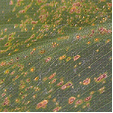
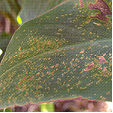 Canna indica
Canna indica
Centaurea species are infected by the rust (Puccinia cyani) and (Puccinia irrequisita) which can cover the stems and leaves.
Cleome species are infected by the rust (Puccinia aristidae) but rarely requires control.
Dianthus species are infected by the rust (Uromyces dianthi) which forms powdery brown spots that appear on both sides of the leaves. The leaves curl and die and the plant becomes stunted. This is a common problem that occurs when grown in a protected enclosure (hot house).
Ficus species are infected by the rust (Cerotelium fici) which forms small brown spots, and causes the leaves to turn yellow then fall prematurely.
Fuchsia species are infected with (Pucciniastrum epilobii). This fungus caused purplish red blotches on the upper leaf surface, that become dry in the middle and result in a brown patch with purple edges. On the underside of the leaf, corresponding to the patches, yellow orange spores form. Heavily infected leaves become yellow and drop prematurely. This leads to a loss of vigour in the plant and infected plants transmit the fungus.
Certain cultivars are more susceptible than others, particularly 'Orange Drops' and 'Novella'.
Hydrangea species is infected by (Pucciniastrum hydrangeae) causing yellowish brown pustules to appear on both sides of the leaf. The leaf becomes dry and brittle.
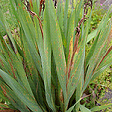
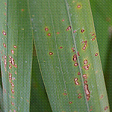 Iris species
Iris species
Iris and Dietes species are very susceptible to the rust (Puccinia iridis). Leaves form rusty red powdery spots that enlarge. They are appear on both sides of the leaves causing the surrounding area to turn pale yellow then brown and the black spores appear soon after, overwintering on dead infected leaves. Plants may be heavily infected but normally survive attack.
Larix species are infected by several Needle Rusts including (Melampsora paradoxa), (Melampsora medusae) and (Melampsoridium betulinum). The fungi attacks the needles predominantly towards the branch tips turning them yellow and eventually killing them . The underside of the leaf develops pale yellow fruiting bodies.
Lupinus species are infected by three species of rust including (Puccinia andropogonis var onobrychidis).
Malus andChaenomeles species may be infected by the rust (Gymnosporangium juniperi-virginianae) or (Gymnosporangium clavipes) which forms brown or bright orange spots on the leaves or twigs and can defoliate the tree. Juniperus virginiana and Mespilus germanica may also be infected by rust.
Mathiola and Arabis species are infected by White Rust.
Pinus species are infects by the Comandra Blister-rust (Cronartium comandre).
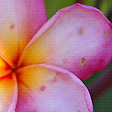
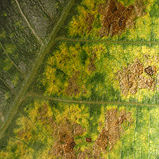
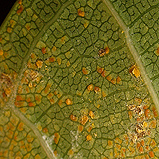
Plumeria rubra Leaf upper surface Leaf underside
Plumeria species are susceptible to the rust (Coleosporium plumeriae). Leaves and flowers may be infected with the underside forming bright yellow pustules and causes premature leaf or flower drop.
Populus nigra 'Italica' is infected by the rust (Melampsora species) which forms pustules to form on the leaves turning them brown and causing premature leaf drop.
Rhododendron and Tsuga species are infected by the rust (Pucciniastrum vaccinii) and is commonly found in nursery stock, spreading rapidly. Tsuga species are also infected by Needle Rust.
Ribes species are infected by the rust (Cronartium ribicola). This leaf rust appears on the underside of the leaves (preferably older leaves) forming dusty brown pustules and is a serious problem. This rust only appears when White Pine (Pinus strobes) grows near where the alternate stage of the fungus occurs.
Rudbeckia species are infected by several species of rust including (Puccinia dioicae) and (Uromyces rudbeckiae).
Salix species are infected by four types of (Melampsora species).
Senecio, Bellis and Calendula species are infected by the rust (Puccinia lagenophora) which forms blister-like pustules that release brown spores.
Sorbus aucuparia is affected by several rust from the (Gymnosporangium species) causing circular yellow spots, that appear on the leaves during summer and develop into orange cup-shaped fruiting bodies.
Trillium species are infected by the rust (Uromyces halstedii) that damages the leaf surface.
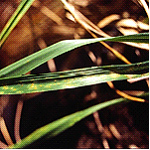 Festuca arundinacea
Festuca arundinacea 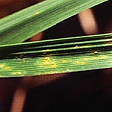 Rust
Rust
Turf Grass are susceptible to rust (Puccinia species) and (Uromyces species), causing yellow flecks to appear on the stems and leaves. These markings enlarge before the pustules form and in severs cases the lawn has a yellow, red or brown appearance.
The infection appears from spring to summer under humid low light conditions and turf that is under stress or with excessive nitrogen in the soil is more susceptible. Many species may be infected including Lolium perenne (Perennial Ryegrass) and Poa pratensis (Kentucky Bluegrass).
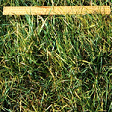
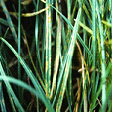 Rust on Perennial Ryegrass
Rust on Perennial Ryegrass
Viburnum species are mildly affected by two types of rust (Coleosporium viburni) and (Puccinia linkii).
Viola species are infected by the rust (Puccinia violae) which forms green spots on the underside of the leaves. It is not commonly seen on cultivated plants.
Non-chemical Control
Cut off and destroy any infected branches, fallen leaves and remove heavily infected plants. Improve the culture by, pruning to improve air circulation, allow space between plants and avoid over crowding. Avoid planting susceptible species. Plants that are infected with a systemic form should be removed and destroyed
Chemical Control
Not possible to spray large trees but young plants may be treated with a protectant fungicide such as wettable sulphur. In a domestic garden small plants such as Fuchsia species may be sprayed with a protectant chemicals as symptoms appear, aided by the removal of existing infected leaves. Under commercial conditions stock may be sprayed with a fungicide such as oxycarboxin.
Note
Always read the label for registration details and direction of use prior to application of any chemicals.
DISEASE
NAME
Downy Mildew (General)
Various Downy Mildew Species
Description
Generally Downy Mildew may occur as a result of several fungal species, but have simular symptoms. The fungus is normally host specific.
Symptoms
The upper leaf forms yellowish, green or translucent patches that become enlarged and eventually the leaf turns yellowish-brown, wilts and dies. It can extend down the petioles onto the plant causing it to collapse and on the underside of the patches downy spores form, these may be grey to mauve or brown to purplish.
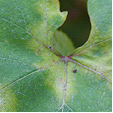
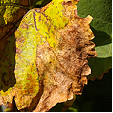
The Downy Mildew (Plasmopara halstedii) forms pale green spots on the upper surface of the leaves with corresponding white felty areas on the underside. The affected leaves contract, turn brown and die; commonly found on Senecio species.
Downy Mildew in Rose (Peronospora sparsa). Angular purplish to dark brown spots or areas develop on the upper leaf surface and under humid conditions, the underside of these areas develop fury fruiting bodies. Young and heavily infected leaves turn brown and fall. The flowers stalks and stems are also attacked with purplish blotches or streaks that may cause them to split. Young growth that is infected dies off and if the flowers are affected in bud blooms become deformed when open.
The spores overwinter on infected plants and fallen leaves and are dispersed by wind infecting new growth during spring.
Downy Mildew in Stocks (Peronospora parasitica). The upper leaf forms yellowish green patches that become enlarged and eventually the leaf becomes yellow, then wilts and dies. It also infects the stems and on the underside of the leaves patches downy grey to mauve-white pustules form where the spores are arranged in rows. This fungus is soil born and commonly dispersed by infected plants.
Source and Dispersal
It is normally found or dispersed on other infected plants. The spores are also spread by wind but are unable to germinate in dry conditions, requiring moisture on the leaf and a humid environment to grow.
Favoured Conditions
It prefers warm humid days with cool nights and spread quickly in closely planted seedlings or plants.
Affected Plants
A wide range of vegetables, annuals, perennials and shrubs are affected. Plants such as stocks and seedlings are at most risk commonly causing the plant to collapse and die.
Aster species are infected by the downy mildew (Basidiophora entospora).
Mathiola incana and Arabis species is infected by (Peronospora parasitica) causing stunting with downy mold on the underside of the leaves. Seedlings are at most risk commonly causing the plants to collapse and die.
Rudbeckia species are infected by the downy mildew (Plasmopara halstedii) causing yellowing of the foliage, wilting and in some cases death of the plant.
Turf Grasses are susceptible to the downy mildew (Scleropthora macrospore), which may not appear downy on the leaves but leaves affected are stunted, thickened or become broad and only under severe cases small yellow patches up to 100mm wide appear in the turf.
Veronica species are infected by the downy mildew (Peronospora grisea). Symptoms include leaves form pale spots on the upper surface while greyish mildew forms correspondingly on the underside.
Viola species ate infected with (Bremiella megasperma) which forms irregular greyish spots on the upper surface and felt-like growth on the underside.
Non-chemical Control
Infected plants must be removed and destroyed and avoid over planting seedbeds. Avoid watering from above or over watering to reduce humidity. When planting out space the plants to allow good air circulation as a dry atmosphere halts or reduces the infection. Select resistant plant species when planting.
Improve drainage and aeration of the soil in affected Turf grasses and avoid overwatering.
Chemical Control
With seedlings drench the soil with a systemic root absorbing fungicide such as furalaxy. Plants can be sprayed with a protectant fungicide such as copper oxychloride or zineb if the weather conditions are favourable for fungal attack. Be certain to thoroughly cover the under side of the leaves.
DISEASE
NAME
Leaf Nematodes
Aphelenchoides species
Description
These microscopic size soil borne nematodes attack leaves by entering through the stomates but are restricted by the veins. The nematode can resurface and move around the leaf in water, infesting other parts of the leaf.
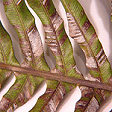
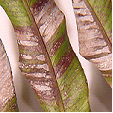
Leaf Nematode (Aphelenchoides ritzema-bosi) enters the plant when the stems and wet allowing the nematode swim to the stomates in the leaf. The leaf forms yellowish to brown spots that are contained by the veins but merge eventually turning the entire leaf brown then dieing. It infects greenhouse and outdoor Chrysanthemum and Penstemon species.
Stem Nematode (Ditylenchus dipsaci) enters through the stomates in young shoots and working upwards as thew stem grows causing the leaves to become malformed. Flowers fail to open, stems may grow sideways and the plant becomes stunted, dieing prematurely. The main host is Phlox species but not all are affected.
Symptoms
Infested fronds of ferns turn brown to black and may die prematurely. Other softer foliage plants such as Chrysanthemums form yellow spots initially that are constricted by veins. These areas become dark brown turning black in severs attacks with the leaf withering and collapsing.
Source and Dispersal
The nematodes remain active in plant material for up to 18 months. They are dispersed by infected plant cuttings or soil and travel along a film of water on the outside of the plant. They can also be dispersed by splashing water from the soil or from another plant.
Favoured Conditions
Humid cool conditions are preferred, as in after periods of rain or following overhead watering. They also prefer over crowded fernery stock.
Affected Plants
A wide range of plants are affected these include, Australian native plants in the Asteraceae family or Anigozanthos and Lophostemon species. Ferns such as Asplenium, Blechnum and Pteris species are also susceptible.
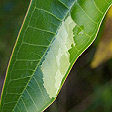 Plumeria acutifolia
Plumeria acutifolia
Many ornamentals, perennials, annuals, trees and shrubs are also attacked include;
Begonia, Bergenia, Chrysanthemum, Coleus, Cyclamen, Gloxinia, Impatient, Penstemon, Plumeria and Saintpaulia species.
Ficus and Philodendron species are occasionally attacked by the leaf nematode (Aphelenchoides fragariae) forming angular markings that are water soaked at first, and then turning brown appearing on the leaf surface.
Non-chemical Control
Heavily infected plants and infested parts should be removed and burnt. Infected plant parts may be immersed in hot water at 45 deg for up to 15 minutes. This can only be used in local infestations and the immersed period varies according to the species.
Be certain to propagate from uninfected plant material and avoid replanting with susceptible species.
Chemical Control
Application of a systemic pesticide such as Fenthion are effective, but must be used as soon as the damage appears and repeated fortnightly.
Note
Always read the label for registration details and direction of use prior to application of any chemicals.
DISEASE
NAME
Spotted Wilt Virus
Various Spotted Wilt Virus
Description
Viral problem that infects the leaves and stems of many plants.
Symptoms
Spotted Wilt Virus is a systemic disease that attacks a variety of plants with variable symptoms. In tomatoes young plants are particularly venerable, as indefinite mottling or rings first form on the upper surface of young leaves, eventually covering the leaf, causing it to shrivel and die. Stems and petioles or peduncles develop brownish streaks as the virus spreads eventually killing the young plants.
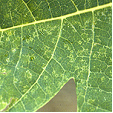 Pawpaw
Pawpaw
Older plants that are attacked produce new foliage that is mottled with bronze colouring which soon turns black causing the leaf to shrivel and die. Stems can also be affected with brown streaks and fruit of an infected plant, ripens unevenly and is marked with circular blotches. This may cause premature fruit fall.
Spotted wilt also causes plants to become stunted and for flowers to develop reddish or yellow rings.
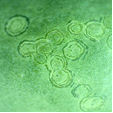 Fruit
Fruit
Source and Dispersal
The virus is found on other infected plants and is spread by thrips, particularly Onion thrips (Thrips tabaci) and Western Flower Thrips (Frankliniella schultzei). The virus may also be dispersed in infected rhizomes or tubers or nursery stock.
Favoured Conditions
Hot dry weather favours thrips activity particularly during summer, spreading the virus which appears 2 to 3 weeks later.
Affected Plants
A wide range of vegetables and ornamentals are attacked include capsicums, potatoes, broad beans and
Amaryllis, Anemone, Antirrhinum, Aster, Begonia, Calceolaria, Calendula, Chrysanthemum, Dahlia, Gerbera, Lactuca, Lathyrus, Lilium, Lycopersicon (Tomato), Nasturtium, Papaver, Pericallis, Petunia, Phlox, Schizanthus and Zinnia species.
All have simular symptoms with yellowish wavy marks that spread causing the leaf to distort turn brown and die.
Other plants such as Zephyranthes species develop yellow or parallel streaks on the leaves that spread to the stems.
Non-chemical Control
Preventative measures are important for the uninfected plants by not planting near tomato crops and the removal of weeds. The controlling of thrip infestations greatly reduces distribution of the virus.
Chemical Control
There is no chemical control of viral problems.
Average Lowest Temperature : -5º C 23º F
USDA : 6, 7, 8, 9, 10
This USDA (United States Department of Agriculture) hardiness zone chart can be used to indicate a plant’s ability to withstand average minimum temperatures. However, other factors such as soil type, pH, and moisture, drainage, humidity and exposure to sun and wind will also have a direct effect on your plant’s survival. Use this chart only as a guide, always keep the other factors in mind when deciding where, when and what to plant.
A plant's individual USDA zone can be found in the Plant Overview.
Region of origin
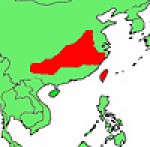
China, Taiwan
Climate Description
Cool Temperate
This zone has low winter temperatures and moderate summer temperatures with low humidity and cool nights. Frosts are severe with snow at higher altitudes.
Drought rarely occurs and wind is cold inland or wet on the coast.
Plant growth
Cool weather plants grow well.
| Dictionary | Growth Habit |
| Leaf Type | Botanic Flower Description |
| Leaf Shape | Flower Inflorescence |
| Leaf Arrangement | Fruit Type |
| Leaf Margin | Bark Type |
| Leaf Apex And Bases | Flower Description |